Introduction
A GPS dog fence is an advanced pet containment system that utilizes satellite technology to establish virtual boundaries for your furry friend. It provides a safe and effective way to keep your dog within a specified area without the need for physical fences or barriers. In this comprehensive guide, we’ll delve into the world of GPS dog fences, exploring their features, benefits, market insights, and future trends.

Understanding GPS Dog Fences
How It Works
GPS dog fences work on the principle of satellite navigation. The system comprises a receiver collar worn by the dog and a base station or transmitter installed in your yard. The base station emits a signal that is received by the collar. Using triangulation, the collar determines its position relative to the base station and ensures the dog remains within the designated boundaries.
Features and Benefits
- Virtual Boundaries: GPS dog fences allow you to create invisible boundaries anywhere within the coverage area, eliminating the need for physical fences.
- Real-Time Tracking: The collar constantly transmits the dog’s location, providing you with peace of mind and the ability to track their whereabouts in real-time.
- Training Modes: Most GPS dog fences offer multiple training modes, such as audible warnings, vibration, and static correction, to reinforce boundaries and encourage desired behaviors.
- Remote Monitoring: With GPS dog fence apps, you can remotely monitor your dog’s activity, adjust boundaries, and receive notifications from anywhere with an internet connection.
- Waterproof and Durable: GPS dog fence collars are designed to withstand rain, snow, and other outdoor conditions, ensuring reliable performance in all weather.
Market Insights
Growing Popularity
According to a recent study by Allied Market Research, the global pet containment systems market is projected to reach $2.4 billion by 2025, with GPS dog fences driving significant growth. The increasing adoption of pets, along with the demand for convenient and effective pet containment solutions, is fueling this growth.
Technological Advancements
GPS dog fence technology has witnessed significant advancements in recent years. The use of high-precision GPS receivers, enhanced battery life, and improved training algorithms has resulted in more accurate and reliable systems. Additionally, the integration of AI and machine learning is paving the way for personalized training experiences tailored to individual dogs.
Future Trends
Smart Integration
GPS dog fences are expected to become even more integrated with other smart devices, such as home automation systems and pet health trackers. This integration will allow for seamless monitoring and control of your dog’s well-being and surroundings.
Personalized Training
The future of GPS dog fences lies in personalized training. AI algorithms will be able to analyze a dog’s behavior and adjust training parameters accordingly, optimizing the learning process and achieving faster and more effective results.
Current Status and Improvements
Current Status
While GPS dog fences offer numerous benefits, they also have some limitations. The coverage area can be limited by terrain and vegetation, requiring careful planning and adjustment of boundaries. Additionally, the cost of GPS dog fences can be higher compared to traditional physical fences.
How to Improve
To address these limitations, manufacturers are working on improving GPS accuracy, extending coverage areas, and developing more affordable options. Additionally, the development of self-correcting and adaptive boundary systems will enhance the overall user experience.
Step-by-Step Approach to Using a GPS Dog Fence
- Plan the Boundaries: Determine the area you want to contain your dog within and mark the boundaries using flags or temporary markers.
- Install the Base Station: Place the base station in a central location within the designated area and secure it according to the manufacturer’s instructions.
- Fit the Dog Collar: Attach the GPS collar to your dog’s neck and adjust it for a snug but comfortable fit.
- Set Up Training Mode: Select the appropriate training mode based on your dog’s temperament and previous training experience.
- Start Training: Gradually introduce your dog to the GPS dog fence by walking the boundaries with them, rewarding them for staying within the area.
- Monitor and Adjust: Use the GPS dog fence app to track your dog’s activity and make necessary adjustments to the boundaries or training settings as needed.
Unlocking New Applications
The versatility of GPS dog fences allows for innovative applications beyond pet containment. For instance, they can be used for:
- Wildlife Tracking: Monitoring the movements of wild animals for research and conservation purposes.
- Agricultural Monitoring: Tracking livestock and preventing them from wandering into restricted areas.
- Remote Asset Management: Monitoring valuable equipment or assets in remote locations.
Conclusion
GPS dog fences have revolutionized pet containment, providing pet owners with a convenient, effective, and customizable solution. With ongoing advancements in technology, they are poised to become even more sophisticated and versatile. As the demand for pet containment systems continues to grow, GPS dog fences will undoubtedly remain at the forefront, offering a valuable tool for responsible and modern pet ownership.





















